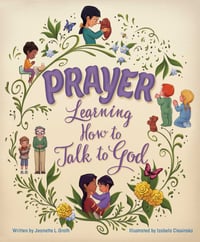I will always remember the surprise and joy of listening to my brother’s first spontaneous prayer. In our family of six, my parents strove to lead nightly devotions and prayers. Though we didn’t get to it every night, it was enough that my brother, the youngest, was able to catch on to what we were doing. After a group prayer, the rest of us would take turns saying prayers out loud. In the middle of someone else’s petition, he suddenly burst out, “Thank You for the sandbox!” Then we knew it was time for Dalen to have a turn in our nightly prayers.
There is no one right way to teach your child to pray, but if you’re having trouble knowing where to start, here are some ideas for how to think about it and what you can do.
Modeling Prayer
Let your child see you do it. Pray out loud while holding your babies. Pray out loud at mealtimes, bedtime, and when you need help. Children truly do look up to the loving adults in their lives and want to do what they do, including pray.
Prayer Posture
I know you (adult reader) say prayers every day that do not involve kneeling, closing your eyes, or folding your hands. However, when in a group setting, my guess is that you typically take on some form of posture, whether it be bowing your head or folding your hands. In a group setting, the posture can serve as a signal that you’re participating.
That kind of signal is very helpful when teaching children. The posture of folded hands and bowed heads shows that something important is happening. It also serves to help them not be distracted by others in the room. (There is no cure-all for shutting out distractions, but it does help.) Quiet lips and listening ears teach reverence and respect to God. Folded hands also provide a way for children (even a year or younger) to participate in prayer before they know how to speak or what to say.
When to Pray
The two most common times to pray outside of church are before meals and before bed. Make sure to take advantage of both those times for prayer.
You can also look for other routine times and natural opportunities to pray throughout the day. During school, we say a prayer at the beginning of circle time, before snack, and at the end of our Bible story time. At home, you might say prayers when you get in the car or when you hear an emergency vehicle siren. When your child expresses a specific fear (thunder, the dark), say a prayer together. When your child is having a hard time, say a prayer.
What to Say
Pre-written prayers
Learning rhymes and poems is important for children’s language development in general, so don’t feel the need to shy away from prayers like that. Simple rhyme is developmentally appropriate for them. Here are a few mealtime prayer ideas:
- Come, Lord Jesus, and be our guest. Let these, Thy gifts, to us be blessed.
- Let us give thanks unto the Lord, for He is good; His mercy endures forever.
- A B C. 1 2 3. Thank You, God, for feeding me.
- Our hands we fold, our heads we bow. For food and drink, we thank God now.
- God is great, God is good. Let us thank Him for our food. By His hand, we all are fed. Thank You, God, for daily bread.
Spontaneous prayer
As children gets older (by older, I mean two, three, or four years old), you can start to teach them to make their own petitions of thanks, of praise, and asking for help. In my classroom, we call it the “pass the cross” prayer. We sit in a circle and pass around a small wooden cross. When a child gets the cross, it’s his or her turn to say, “God, thank You for _______.” I give students that exact pattern of words so that they don't get overwhelmed figuring out what to say. Other word patterns can be “God, please be with ________” or “God, please help me ________.”
I also like to give students time to think about what they would like to say thanks for before we start the prayer. It can be hard to think of something on the spot, even for a child.
Some families like to share the highs and lows of their day with one another. When your child shares a good thing about the day, thank God specifically for that thing. When your child shares something that was a bummer, help your child take that to God in prayer too.
The Lord’s Prayer
 And, of course, you can use the prayer that Jesus taught us to pray. Start by praying the Lord’s Prayer out loud while your child participates by folding his hands. As he becomes ready, you can teach it a little at a time. You might be surprised how quickly he catches on. They key is doing it often so the words become familiar. Your child may not know the meaning of all the words yet. That’s okay. Keep building the language so it becomes familiar. (And take time to explain some of those big words just a little at a time.)
And, of course, you can use the prayer that Jesus taught us to pray. Start by praying the Lord’s Prayer out loud while your child participates by folding his hands. As he becomes ready, you can teach it a little at a time. You might be surprised how quickly he catches on. They key is doing it often so the words become familiar. Your child may not know the meaning of all the words yet. That’s okay. Keep building the language so it becomes familiar. (And take time to explain some of those big words just a little at a time.)
Remember that we all need Jesus
Little people carry burdens too. They need help listening to mom and dad, potty training, giving up thumb-sucking or using a pacifier. They have bad dreams and fear the dark. We may laugh about some of those burdens later on, but when happening, these things are very real to children. Help your children take their troubles to God now so that, as they grow, they can take their bigger troubles to Him too.
God be with you as teach, model, and pray with your children. May you always bring your burdens to Jesus and receive rest in Him. “Come to Me, all who labor and are heavy laden, and I will give you rest” (Matthew 11:28 ESV).
 Keep up the momentum of praying with your kids by reading together with Prayer: Learning How to Talk to God by Jeanette Groth. You'll find engaging illustrations and guidance for saying prayers at any time or place.
Keep up the momentum of praying with your kids by reading together with Prayer: Learning How to Talk to God by Jeanette Groth. You'll find engaging illustrations and guidance for saying prayers at any time or place.















